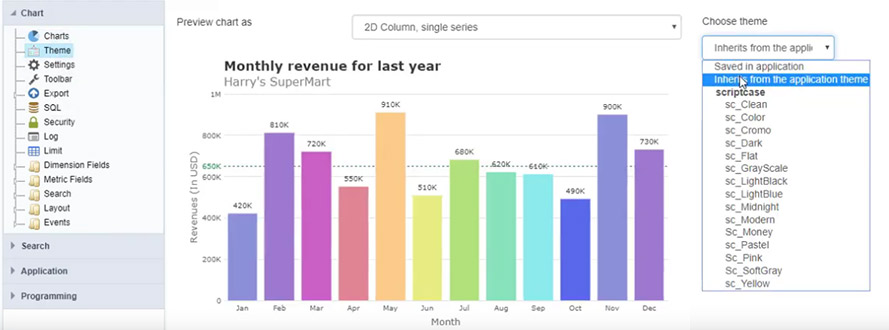- New Themes Released And 1m Users 2017
- New Themes Released And 1m Users List
- New Themes Released And 1m Users Guide
- New Themes Released And 1m Users Must
At this time, users of the Enigmail Add-on should not update to Thunderbird 78. OpenPGP functionality for Thunderbird 78 is still work in progress, and is disabled by default in the initial 78.0 release. LibreOffice 7.0 is the latest major release after version 6.4. There are plenty of additions to improve the LibreOffice experience. In this article, I’ll share some details on the key changes on LibreOffice 7 and how to get it.
Microsoft’s Edge browser is getting yet another big update. This time around, the new Chromium-based Edge us getting access to a bunch of new themes as well as new password management capabilities. First up, the new themes. Microsoft dropped a teaser video (below) showcasing several themes. There are a few with basic colours, as well.
-->Applies to
- Windows 10, version 20H2
This article lists new and updated features and content that is of interest to IT Pros for Windows 10, version 20H2, also known as the Windows 10 October 2020 Update. This update also contains all features and fixes included in previous cumulative updates to Windows 10, version 2004.
Note
With this release and future releases, the Windows 10 release nomenclature is changing from a year and month pattern (YYMM) to a year and half-year pattern (YYH1, YYH2).
As with previous fall releases, Windows 10, version 20H2 is a scoped set of features for select performance improvements, enterprise features, and quality enhancements. As an H2-targeted release, 20H2 is serviced for 30 months from the release date for devices running Windows 10 Enterprise or Windows 10 Education editions.
To download and install Windows 10, version 20H2, use Windows Update (Settings > Update & Security > Windows Update). For more information, including a video, see How to get the Windows 10 October 2020 Update.
Microsoft Edge
This release automatically includes the new Chromium-based Microsoft Edge browser instead of the legacy version of Edge. For more information, see the Microsoft Edge documentation.
Servicing
Windows Update
There are several changes that help improve the security of devices that scan Windows Server Update Services (WSUS) for updates. For more information, see Changes to improve security for Windows devices scanning WSUS.
New Themes Released And 1m Users 2017

Starting with Windows 10, version 20H2, LCUs and SSUs have been combined into a single cumulative monthly update, available via Microsoft Catalog or Windows Server Update Services. For more information, see Simplifying on-premises deployment of servicing stack updates.
Deployment
New guidance is available to help prepare a servicing strategy and move your devices to the latest version of Windows 10 quickly and as seamlessly as possible.
Activities are grouped into the following phases: Plan > Prepare > Deploy:
Plan your deployment by evaluating and understanding essential activities:
- Create a phased deployment plan
- Assign roles and responsibilities within your organization
- Set criteria to establish readiness for the upgrade process
- Evaluate your infrastructure and tools
- Determine readiness for your business applications
- Create an effective, schedule-based servicing strategy
Prepare your devices and environment for deployment by performing necessary actions:
- Update infrastructure and tools
- Ensure the needed services are available
- Resolve issues with unhealthy devices
- Ensure that users are ready for updates
Deploy and manage Windows 10 strategically in your organization:
- Use Windows Autopilot to streamline the set up, configuration, and delivery of new devices
- Use Configuration Manager or MDT to deploy new devices and update existing devices
- Use Windows Update for Business with Group Policy to customize update settings for your devices
- Deploy Windows updates with Windows Server Update Services (WSUS)
- Manage bandwidth for updates with Delivery Optimization
- Monitor Windows Updates with Update Compliance
Windows Autopilot
Enhancements to Windows Autopilot since the last release of Windows 10 include:
- Windows Autopilot for HoloLens: Set up HoloLens 2 devices with Windows Autopilot for HoloLens 2 self-deploying mode.
- Windows Autopilot with co-management: Co-management and Autopilot together can help you reduce cost and improve the end user experience.
- Enhancements to Windows Autopilot deployment reporting are in preview. From the Microsoft Endpoint Manager admin center (endpoint.microsoft.com), select Devices > Monitor and scroll down to the Enrollment section. Click Autopilot deployment (preview).
Windows Assessment and Deployment Toolkit (ADK)
There is no new ADK for Windows 10, version 20H2. The ADK for Windows 10, version 2004 will also work with Windows 10, version 20H2. For more information, see Download and install the Windows ADK.
Device management
Modern Device Management (MDM) policy is extended with new Local Users and Groups settings that match the options available for devices managed through Group Policy.
For more information about what's new in MDM, see What's new in mobile device enrollment and management
Security
Microsoft Defender for Endpoint
This release includes improved support for non-ASCII file paths for Microsoft Defender Advanced Threat Protection (ATP) Auto Incident Response (IR).
The DisableAntiSpyware parameter is deprecated in this release.
Microsoft Defender Application Guard for Office
Microsoft Defender Application Guard now supports Office: With Microsoft Defender Application Guard for Office, you can launch untrusted Office documents (from outside the Enterprise) in an isolated container to prevent potentially malicious content from compromising your device.
Windows Hello
With specialized hardware and software components available on devices shipping with Windows 10, version 20H2 configured out of factory, Windows Hello now offers added support for virtualization-based security with supporting fingerprint and face sensors. This feature isolates and secures a user's biometric authentication data.
Virtualization
Windows Sandbox


New policies for Windows Sandbox are available in this release. For more information, see Policy CSP - WindowsSandbox.
Windows Virtual Desktop (WVD)
Note: WVD is not tied directly to a Windows 10 release, but it is included here as an evolving capability of Windows.
New capabilities in WVD were announced at Ignite 2020. For more information, see Announcing new management, security, and monitoring capabilities in Windows Virtual Desktop.
New Themes Released And 1m Users List
In addition, Windows Virtual Desktop is now generally available in the Azure Government cloud.
Windows Shell
Some enhancements to the Windows 10 user interface are implemented in this release:
- With this release, the solid color behind tiles on the Start menu is replaced with a partially transparent background. Tiles are also theme-aware.
- Icons on the Start menu no longer have a square outline around each icon.
- Notifications are slightly updated in appearance.
- You can now change the monitor refresh rate on advanced display settings.
- Alt+Tab now shows Edge browser tabs by default. You can edit this setting under Settings > System > Multitasking: Alt+Tab.
- The System control panel under System and Security has been updated to the Settings > About page. Links to Device Manager, Remote desktop, System protection, Advanced system settings, and Rename this PC are moved to the About page.
2-in-1 PCs
On a 2-in-1 device, Windows will now automatically switch to tablet mode when you detach the screen.
Surface
Windows 10 Pro and Enterprise are now available on Surface Hub 2. For more information, see What's new in Surface Hub 2S for IT admins.
Desktop Analytics
Desktop Analytics is a cloud-connected service, integrated with Configuration Manager that providess New in Windows Server: New and updated features in Windows Server.
Windows 10 Features: General information about Windows 10 features.
What's New in Windows 10: See what’s new in other versions of Windows 10.
Announcing more ways we’re making app development easier on Windows: Simplifying app development in Windows.
Features and functionality removed in Windows 10: Removed features.
Windows 10 features we’re no longer developing: Features that are not being developed.
This topic applies to Dynamics 365 Customer Engagement (on-premises). For the Power Apps version of this topic, see:Use a theme to create a custom look for your app
You can create a custom look and feel (a theme), for your app by making changes to the default colors and visual elements provided in the uncustomized system. For example, you can create your personal product branding by adding a company logo and providing entity-specific coloring. A theme is created by using the customization tools in the user interface, without requiring a developer to write code. You can create, change or delete themes that are used in your organization. The theme customization is supported in the Web forms in Dynamics 365 for Outlook. You can define multiple themes, but only one can be set and published as the default theme.
Use themes to enhance the user interface and create your product branding
Theming is used to enhance the app user interface, not drastically alter it. The theme colors are applied globally throughout the application. For example, you can enhance the following visual elements in the UI:
Change product logos and navigation colors to create product branding
Adjust accent colors, such as hover or selection colors
Provide entity-specific coloring
Logo
Logo tooltip
Navigation bar color
Navigation bar shelf color
Main command bar color on the Unified Interface
Header color
Global link color
Selected link effect
Hover link effect
Legacy accent color (primary background for process controls)
Default entity color
Default custom entity color
Control shade
Control border
Solution awareness
The theme is not solution aware. The changes made for an organization's theme aren’t included in solutions exported from the organization. The data is stored in the theme entity that can be exported and re-imported in other environment. The imported theme must be published to take effect.
Copy and alter the existing theme
The easiest and quickest way to create a new theme is to clone and alter an existing theme, then save it, preview and publish.
- Go to Settings > Customizations.
- Choose Themes, and then choose Dynamics 365 Default Theme.
The following screenshot shows the default theme setup.
We cloned the default theme and changed the colors. The following screenshots show the new colors for navigation and highlighting. You can also choose a new logo for product.
The following screenshot shows the new navigation color.
The following screenshot shows the account entity grid with the new highlight color.
Preview and publish a theme
To preview and publish a theme, do the following steps:
Create a new theme from scratch or clone an existing one.
Preview the new theme by choosing Preview on the command bar. To exit the Preview mode, choose Exit Preview on the command bar, next to the Preview button.
Publish a theme. Choose Publish Theme on the command bar.
The following screenshot shows the buttons on the command bar for preview and publishing.
Best practices
New Themes Released And 1m Users Guide
Following are the recommendations for designing theme contrasts and choosing colors.
Theme contrast
We recommend the following approach to providing contrast colors:
Carefully choose the contrasting colors. Customer Engagement out-of-the-box default theme has the correct contrast ratios to ensure optimal usability. Use similar contrast ratios for your new themes.
For high contrast mode, use the default color settings.
Theme colors
We recommend that you don’t use a large number of different colors. Although you can set a different color for every entity, we recommend one of two patterns:
Make all entities in neutral colors and highlight the key entities.
Use the same color for similar entities or related entities, such as queue and queue item, or product catalog entities. Keep the total number of groups low.
Custom theme considerations
New Themes Released And 1m Users Must
You should consider the following when planning on using custom themes:
Most updated user interface (UI) areas will be displayed in the custom theme colors.
Even though the theme colors are applied globally throughout the application, some legacy UI areas, such as gradient buttons, will retain the default colors.
Certain areas must use dark or light colors to contrast with the default icon colors. The icon color isn’t customizable.
An entity can’t be displayed in different colors under different Sitemap nodes.
The Sitemap nodes colors aren’t customizable.
See also
